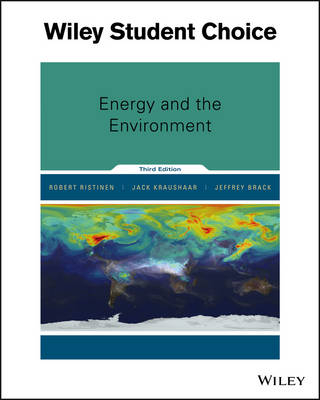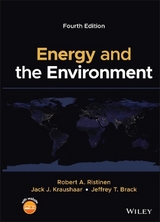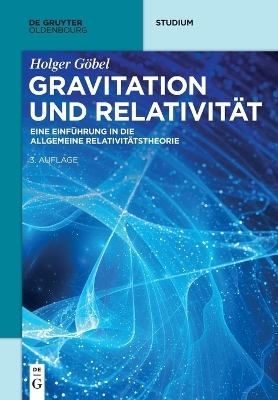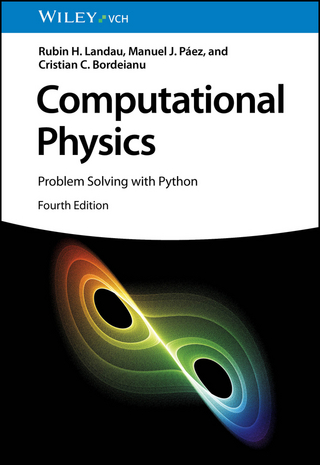
Energy and the Environment
John Wiley & Sons Inc (Verlag)
978-1-119-23958-1 (ISBN)
- Titel erscheint in neuer Auflage
- Artikel merken
Chapter 1 Energy Fundamentals, Energy Use in an Industrial Society 1
1.1 Introduction 1
1.2 Why Do We Use So Much Energy? 4
1.3 Energy Basics 7
1.3.1 General 7
1.3.2 Forms of Energy 8
1.3.3 Power 10
1.4 Units of Energy 11
1.4.1 The Joule 11
1.4.2 The British Thermal Unit 11
1.4.3 The Calorie 12
1.4.4 The Foot-Pound 12
1.4.5 The Electron-Volt 12
1.5 Scientific Notation 12
1.6 Energy Consumption in the United States 14
1.7 The Principle of Energy Conservation 20
1.8 Transformation of Energy from One Form to Another 21
1.9 Renewable and Nonrenewable Energy Sources 22
1.9.1 Nonrenewable Energy Sources 22
1.9.2 Renewable Energy Sources 22
Key Terms 24
Suggested Reading and References 24
Questions and Problems 24
Multiple Choice Questions 25
Chapter 2 The Fossil Fuels 28
2.1 Introduction 28
2.2 Petroleum 29
2.3 History of the Production of Petroleum in the United States 30
2.4 Petroleum Resources of the United States 32
2.5 World Production of Petroleum 35
2.6 The Cost of Gasoline in the United States 36
2.7 Petroleum Refining 37
2.8 Natural Gas 39
2.9 The History of Use of Natural Gas 41
2.10 The Natural Gas Resource Base in the United States 43
2.11 The Natural Gas Resource Base for the World 44
2.12 The Formation of Coal 46
2.13 Coal Resources and Consumption 46
2.14 Shale Oil 49
2.15 Tar Sands 52
2.16 Summary 52
Key Terms 53
Suggested Reading and References 54
Questions and Problems 54
Multiple Choice Questions 55
Chapter 3 Heat Engines 57
3.1 The Mechanical Equivalent of Heat 57
3.2 The Energy Content of Fuels 58
3.3 The Thermodynamics of Heat Engines 59
3.4 Generation of Electricity 61
3.5 Electric Power Transmission 63
3.6 Practical Heat Engines 65
3.6.1 Steam Engines 65
3.6.2 Gasoline Engines 67
3.6.3 Diesel Engines 67
3.6.4 Gas Turbines 70
3.7 Heat Pumps 71
3.8 Cogeneration 74
Key Terms 76
Suggested Reading and References 76
Questions and Problems 76
Multiple Choice Questions 77
Chapter 4 Renewable Energy Sources I: Solar Energy 81
4.1 Introduction 81
4.2 Energy from the Sun 82
4.3 A Flat-Plate Collector System 87
4.4 Passive Solar 91
4.5 Solar Thermal Electric Power Generation 94
4.5.1 Power Towers 96
4.5.2 Parabolic Dishes and Troughs 97
4.6 The Direct Conversion of Solar Energy to Electrical Energy 100
4.7 Solar Cooling 106
Key Terms 107
Suggested Reading and References 107
Questions and Problems 108
Multiple Choice Questions 108
Chapter 5 Renewable Energy Sources II: Alternatives 111
5.1 Introduction 111
5.2 Hydropower 112
5.3 Wind Power 118
5.4 Ocean Thermal Energy Conversion 125
5.5 Biomass as an Energy Feedstock 130
5.6 Biomass: Municipal Solid Waste 135
5.7 Biomass-Derived Liquid and Gaseous Fuels 136
5.8 Geothermal Energy 140
5.9 Tidal Energy 145
5.10 Wave Energy 147
5.11 Summary 147
Key Terms 148
Suggested Reading and References 148
Questions and Problems 149
Multiple Choice Questions 150
Chapter 6 The Promise and Problems of Nuclear Energy 152
6.1 Introduction 152
6.2 A Short History of Nuclear Energy 153
6.3 Radioactivity 156
6.4 Nuclear Reactors 157
6.5 The Boiling Water Reactor 159
6.6 Fuel Cycle 162
6.7 Uranium Resources 163
6.8 Environmental and Safety Aspects of Nuclear Energy 165
6.9 Nuclear Reactor Accidents 168
6.9.1 The Chernobyl Disaster 168
6.9.2 Fukushima Daiichi Disaster 169
6.10 Nuclear Weapons 170
6.11 The Storage of High-Level Radioactive Waste 172
6.12 The Cost of Nuclear Power 174
6.13 Nuclear Fusion as an Energy Source 175
6.14 Controlled Thermonuclear Reactions 177
6.15 A Fusion Reactor 178
Key Terms 182
Suggested Reading and References 182
Questions and Problems 183
Multiple Choice Questions 184
Chapter 7 Energy Conservation 187
7.1 A Penny Saved is a Penny Earned 187
7.2 Space Heating 189
7.2.1 Thermal Insulation 190
7.2.2 Air Infiltration 195
7.2.3 Furnaces, Stoves, and Fireplaces 196
7.2.4 Solar and Other Sources of Heat Energy 199
7.2.5 Standards for Home Heating 200
7.3 Water Heaters, Home Appliances, and Lighting 201
7.3.1 Water Heating 201
7.3.2 Appliances 202
7.3.3 Lighting 204
7.3.4 The Energy-Conserving House 206
7.4 Energy Conservation in Industry and Agriculture 208
7.4.1 Housekeeping 208
7.4.2 Waste Heat Recovery and Cogeneration 208
7.4.3 Process Changes 209
7.4.4 Recycling 209
7.4.5 New Developments 210
7.4.6 Help from Public Utilities 211
Key Terms 212
Suggested Reading and References 212
Questions and Problems 213
Multiple Choice Questions 214
Chapter 8 Transportation 216
8.1 Introduction 216
8.2 Power and Energy Requirements 219
8.3 Electric Batteries, Flywheels, Hybrids, Hydrogen, Alcohol 226
8.3.1 Electric Vehicles 227
8.3.2 Flywheel-Powered Vehicles 229
8.3.3 Hybrid Vehicles 232
8.3.4 Hydrogen, Fuel Cells 234
8.3.5 Alcohol as a Transportation Fuel 238
8.4 Mass Transportation 240
Key Terms 243
Suggested Reading and References 243
Questions and Problems 244
Multiple Choice Questions 244
Chapter 9 Air Pollution 247
9.1 Spaceship Earth 247
9.2 The Earth’s Atmosphere 248
9.3 Thermal Inversions 249
9.4 Carbon Monoxide 253
9.5 The Oxides of Nitrogen 258
9.6 Hydrocarbon Emissions and Photochemical Smog 259
9.7 Reduction of Vehicle Emissions 262
9.8 Sulfur Dioxide in the Atmosphere 265
9.9 Particulates as Pollutants 267
9.10 Acid Rain 272
Key Terms 275
Suggested Reading and References 275
Questions and Problems 275
Multiple Choice Questions 276
Chapter 10 Global Effects 279
10.1 Introduction 279
10.2 Ozone Depletion in the Stratosphere 280
10.3 The Greenhouse Effect and World Climate Changes 284
Key Terms 296
Suggested Reading and References 296
Questions and Problems 297
Multiple Choice Questions 298
Appendix 299
A.1 Linear Plots, Semilogarithmic Plots, and Exponential Growth 299
A.2 Fahrenheit, Celsius, and Kelvin Temperature Scales 302
Answers to Selected End-of-Chapter Problems 305
Index 307
| Erscheinungsdatum | 25.11.2021 |
|---|---|
| Verlagsort | New York |
| Sprache | englisch |
| Maße | 203 x 254 mm |
| Gewicht | 658 g |
| Themenwelt | Naturwissenschaften ► Physik / Astronomie |
| ISBN-10 | 1-119-23958-3 / 1119239583 |
| ISBN-13 | 978-1-119-23958-1 / 9781119239581 |
| Zustand | Neuware |
| Haben Sie eine Frage zum Produkt? |
aus dem Bereich



